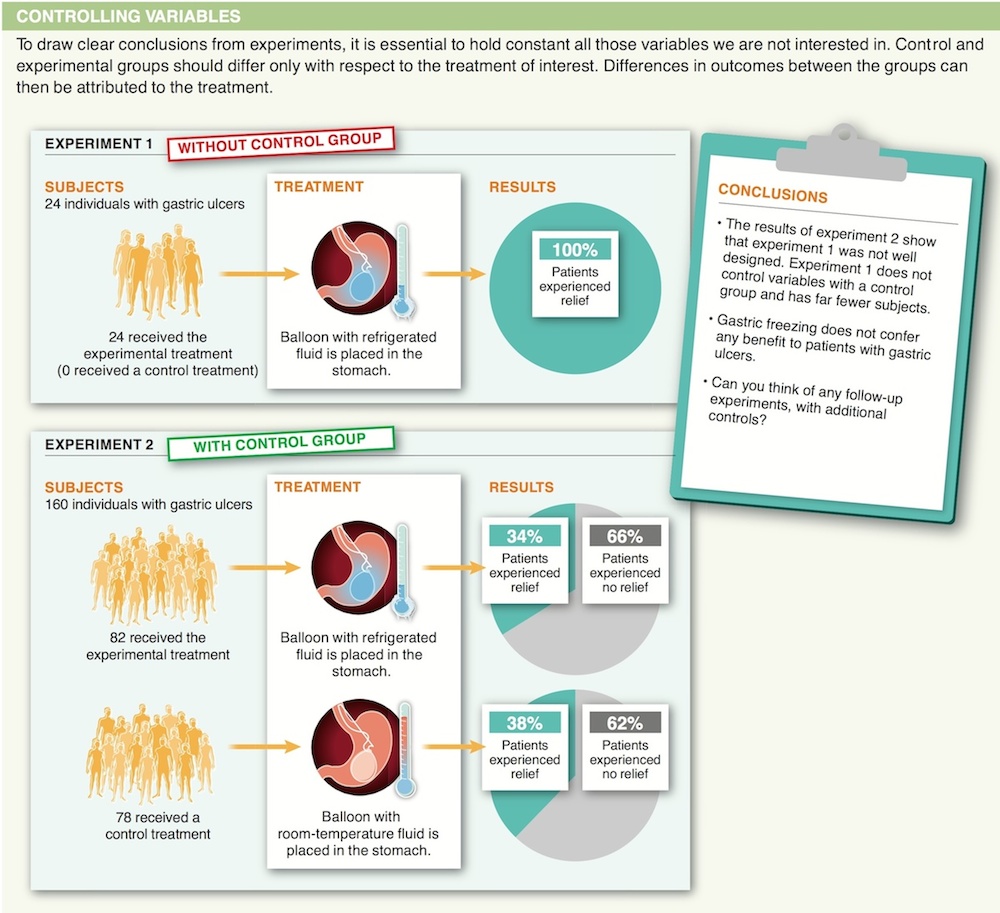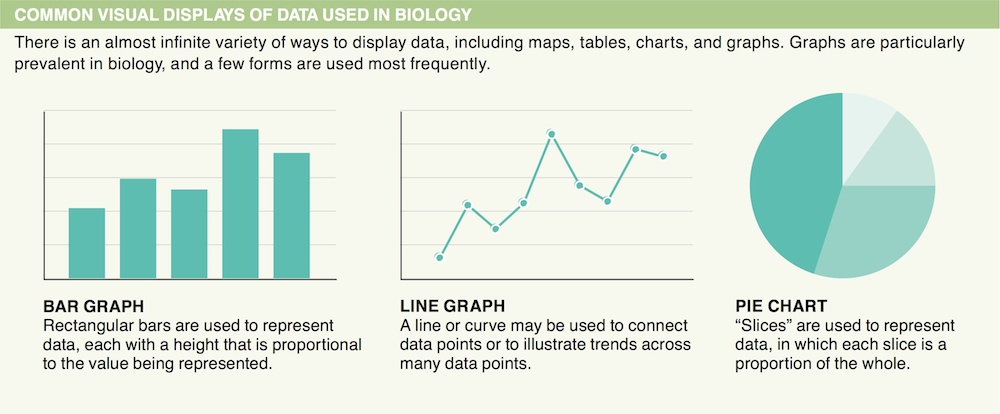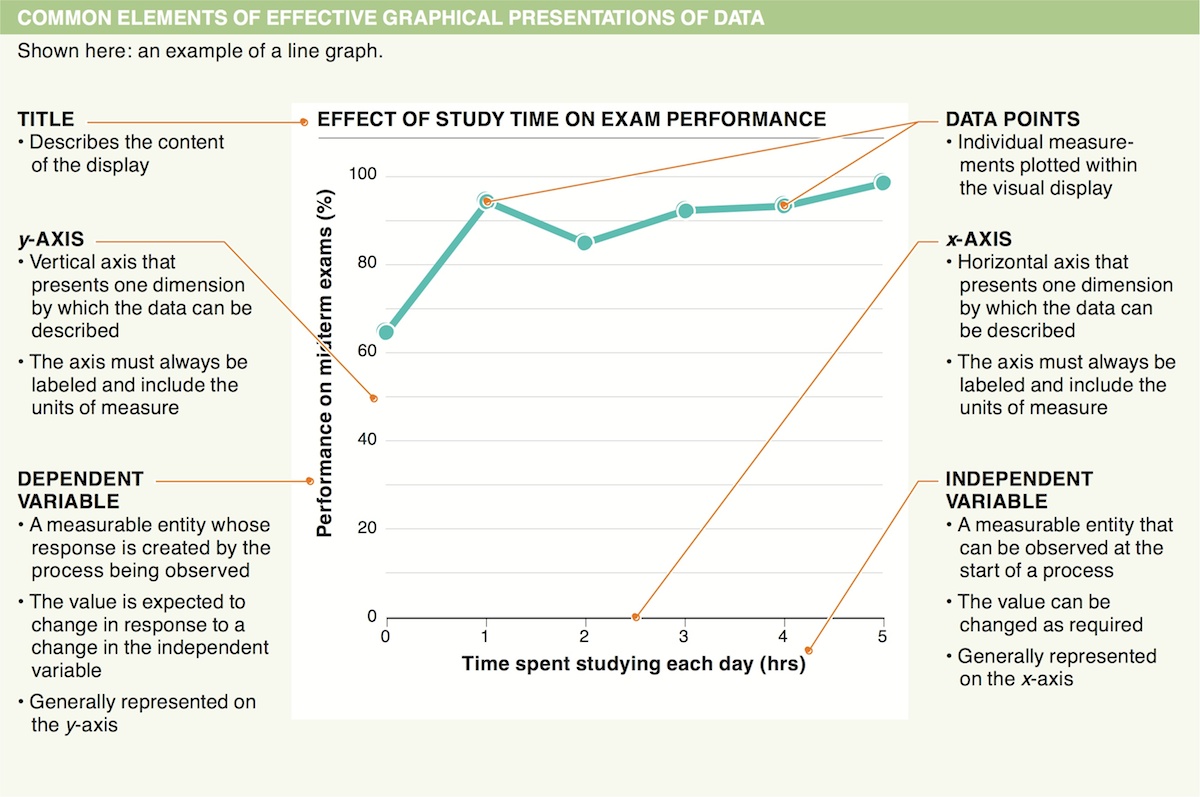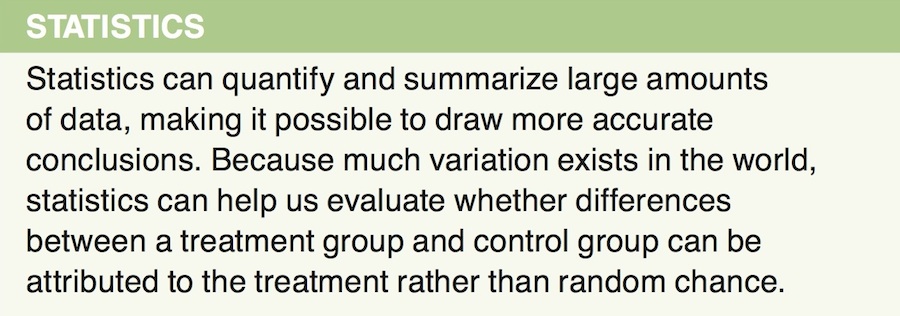Chapter 1. Chapter 1: Scientific Thinking
Review & Rehearse
Review & Rehearse
true
true
You must read each slide, and complete any questions on the slide, in sequence.

Instructions
Review the visual summaries and answer the essay questions below.
Make sure to enter a brief response that completely answers each question and explains your reasoning. When you click "Submit," you will be provided instant feedback, allowing you to check if your response is correct.
(This activity contains 18 total essay questions. Each new question will be revealed once you complete the preceding question.)
Question 1.1


Two claims were made, requiring two double-blind experiments, since only one variable can be changed or tested at a time. Experiment 1: Measure intestinal transit time (the time it takes for consumed foods and other substances to travel through the digestive system) for two groups. Group 1 (control group) does not receive Activia yogurt and instead receives an inert yogurt substitute. Group 2 (experimental group) receives Activia yogurt. Intestinal transit times are measured for both groups. Neither the participants nor the administrators know which participants are consuming Activia and which are consuming the substitute. Data from group 2, the experimental group, are compared with data from group 1, the control group, to determine the effectiveness of Activia. If the data show that intestinal transit time is shorter in the experimental group, the statement by the Dannon Company is supported. Experiment 2: Determine whether DanActive dairy drink helps prevent colds and flu, again using two groups. Group 1 (control group) does not receive DanActive dairy drink and instead receives an inert dairy drink substitute. Group 2 (experimental group) receives DanActive dairy drink. The incidence of colds and flu is measured over a finite period of time, such as one year, for the two groups—the same period of time for both groups. Neither the participants nor the administrators know which participants are consuming DanActive dairy drink and which are consuming the substitute. Data collected from the experimental group are compared with data from the control group. If the incidence of colds and/or flu is lower in the experimental group, the statement made by the Dannon Company is supported.
Question 1.2

Biological literacy can be defined in several ways: (a) The ability to use the process of scientific inquiry to think creatively about real-world issues that have a biological component. Examples could include using the scientific method to answer questions about which plant fertilizers are more effective or to evaluate whether companies’ claims about herbal remedies are legitimate and supported by properly designed experiments. (b) The ability to communicate these thoughts to others. Examples could include discussing with a friend the importance of consuming adequate amounts of calcium or properly making tables and graphs for data collected in experiments. (c) The ability to integrate these ideas into decision making. Examples could include interpreting data from experiments and using this information to make decisions. For instance, you could read and evaluate an article about the benefits of eating a diet rich in fruits and vegetables for reducing certain cancers, then decide whether you and others would benefit from this.
Question 1.3
QNrqs96nrKjv/CXuZOKk6fwql18lnpExLU2NachlfBg6n5w+h6xqBpZy9nf5f72RsY6pbMevLmmL3TQ5+TfLf+n7Q/WdQ0nlSOltzfzCUitfCL5sqY24sbZiwsaBEXTK+8P7mar7oxTfAcJhcXb1/DsAPq6tyolo5xOdTJQPPq88zHqiNRLtV9FQt/lSpEpRB9JbaeAo9j/4HE3UhOR7pT8/j63SrbinIgGQWcB2oTfQaaimSRQXIqQElIL9a4t2tQNT0bvdUYPnNwHM6EDrpJ8oq3BR3mhHCT0ANpx8KBk=“Empirical” refers to knowledge gathered through observations and experiments that are rational, testable, and repeatable. In contrast to this empirical approach, knowledge can also be gained through reason, reflection, and observation in the absence of experimentation.
Question 1.4


Predictions are made based on a formulated hypothesis and are tested with experiments. If a hypothesis is not supported by the experimental results, it can be revised, new predictions made, and these predictions tested with new experiments. Experiments can be repeated many times by many different scientists, and the hypothesis can again be revised and tested if conflicting results arise. In this way the scientific method, done properly, is self-correcting.
Question 1.5
CYYb3JGzv8YgRyMAKfgmAn8mBJI7IAxW1iYDOMrDh6JriIoVaNSbormGDy4PcUG8XyTollfRnGt/YeyACNV/VTcCZ+ZaytuCLcfoWG/GUjpRgKUcjr5aXQQRbDON1gKv9aReALDIEz/UTVLwXz3z9oX8AM8MHWru9Js4oXJDRLCL/JVakJFNK3mZRZ0HIczjP3nyuTi/F9nhVqEP8djxglEvyjaZmYFM0e4oBjBbLV0StOGu2qOteQ==When a phenomenon can be measured, it can be tested through experimentation. To be testable by the scientific method, all examples would need to comply with this requirement. If a phenomenon cannot be measured, it cannot be tested using the scientific method; examples include determining the existence of God or the beauty of Shakespeare’s sonnets.
Question 1.6
Q64Dhrawu4IhHREre7ymgHrIv8M4OzTn9jKw+J60cCWxt5XHT9BkI87ZnZiWvgGk3V+mU7FL57oMB13jcLn0CowW+s8h48JdtgS1PrEZIZLz9lYzMZJoKCxcnA+tTZonTZfmGUYyPVQFswC7hWdxjlgcQtgwzZZrEvvb+wxqf2uSZG89cKUPM+Lmt6yeJBJHBwfi8MY5SJ2TnJ+YThe null hypothesis would state that exercise does not affect the amount of acne a person develops.
Question 1.7
b5g1Uuuxpn34V75783o6/xtYIwm5dCt2E9p4mOZ/EvNHuDWdJ91/TVslRyWO0Ic0oE6kcbxcjOSE3o1usFhZJBFaqIEyGbpBvBABowBOAgs6LvjZfKLR4qYrMjiIYCf1UyLHlL/dzLFoM0x1n7r27hEGknuUXbu5/thAaV41eVm6Bf3JnWeqnA==The prediction would be that a group of people who eat fresh fruits will have a lower rate of illness than another group of people who do not consume fresh fruits.
Question 1.8
K6/Qt4GdXGuosuAymi7w6Ft5gFMv+T3J258B/cvazQjuj56hX5ldw3Wno69PU/ZVp3gFI9hdki7VjupQKey features of an experiment: Treatment: The condition that is changed for members of the experimental group. It is the variable (e.g., temperature, pressure, light) that is changed to test a hypothesis. Only the experimental group experiences this treatment; otherwise, comparison with the control group will not be possible and the hypothesis cannot be properly evaluated. Experimental group: The group that receives the treatment, which is the variable being manipulated to test the hypothesis. Control group: The group for which all variables, with the exception of the treatment, are the same as for the experimental group. This makes it possible to determine differences between the experimental group and control group that result from the variable being tested. Variables: Characteristics that can be changed, such as temperature, quantity and type of food, light, or pressure, and can potentially illicit a change. Blind experimental design: For studies involving human beings, a study design in which the placebo effect and bias can be minimized by preventing members of the experimental group from knowing whether they are part of the experimental (treatment) or control group. However, the experimenters know who is a member of the experimental group or control group. Double-blind experimental design: For studies involving human beings, a study design in which the placebo effect and bias can be minimized by preventing members of the experimental and control groups and the experimenters from knowing who is part of the experimental (treatment) and control groups. Randomized: The random selection of participants to be in either the experimental or control group.
Question 1.9
1hsO5TQbS3IKCO/lC5+I+Z8enM7iQI9K+kEN8mrZQ5G7MmVj9a21wZPbZ9dRr9veEjclZ5DVy340CDI6JyFIP4UOAjgJS2Bl9FGtt4N7M+nTIcHY5zjrDuHhSe/GXz8d8AIE4TXd+oKgtOXCocm8sxwjutJG8hx2QorL5Pj4dqHA1rNyaPLUlI9dq4ooS+jNQGrExWKFwOuTvAnz7JAvtjnMuWYdqAodSUIBpCvkDajw3Y6TfKelbNQA6W/iCeQGOcY+plJxqwYi4QuhQe5Xxs0Jt68NZvYJR7NBQMzqocc6MCHJRgp0rAFjaWx50hMOU8kVVu8qRDoKAFnX0hUZdVrd51h6md1O5qvy8605dEEZWb6W+NQhn52uaH7ml+7z/sjVH4T2V+dT2dq/UNHW2tHvUo0+JMOL7nsACngSclbNOzyGJByCmUWpJunXGNMDKL2heOB+IBmw9Lhkf/HCUM2ZeKlmGD97ZD4fk09LJ8PRE4GY6NwSuNSWreeGaWFDUK8iLDwHm0zGgvIoLKEett7zxhZeSkmEi8/ZBUphiVRGFb/6QxnshdPobVYPEX3l1c2N07MjzMAJLNedGSTCB5ZdTD8hLyVG32W9TwQCkD0qyq01Leo60RKBBGTsoPyROalIT2eBt9tbWmqonzTQCq7T6EbgGQGLp5CcHtGjjQcrXOLIV4SOx+Fus6ANxC8cZHT2oUxMrM3VEYw7RFP1hvEShApNVFaZm191SbYyx/I6fhXxshfVwIz8rBZSUPA5c0Gpj4RvGS0RBSvG4hLcv5hmcOBVmkf8V6KGf7fkKbuRR37YZatqb7HxJhh4ZoJ1KGqsbdKU2JHQw5/Bw8hoTULNoZqTLWZp+4Q894sJhl24yzeboGgsGA+eGwbydF8xNKwTrcyN4wU09+JQF5TJ7iAujl6L9GtWQNRVpbA7ux+x/J8P5WlnQh44T4DnWJJvdq/wCKX0ZxwtACazBQvrjrtMgB+7UE3HvUzj5tuidIFvcYFehZSEFwnPCz/jh4pU(a) Include a control group that does not drink green tea and instead drinks water or other inert drink. (b) Conduct this as a double-blind experiment. (c) Include a large number of people who would be representative of the population advised to drink green tea as a weight-loss method. (d) Stipulate a certain amount of green tea of the same brand to be consumed by study participants. (e) Ensure that only one variable, green tea consumption, differs between the experimental and control groups. Neither group should alter their consumption of food and beverages or change their total calories burned or consumed. (f) Perform a statistical analysis of collected data to determine whether weight loss is significant.
Question 1.10
L66whDuyqyD7qLs+SVOnxH6qmFAaLggWoN0aisiYI1VqqIbFrdRCFI8/COyB5bgd65NMv0WE7CshDa96nNwPAIzdeZiHLJEOQklkL1tqsW4=If the experimental conclusion does not support the hypothesis, the hypothesis can be revised and retested. If the hypothesis is supported by the experimental conclusion, the experiment can be repeated by other scientists. This will ensure the process is self-correcting.
Question 1.11

Both theory and hypothesis are attempts to understand a natural phenomenon. A hypothesis has been proposed but not yet widely tested, whereas a theory has been widely tested by many different scientists with repeated results to support it. Both hypotheses and theories can be revised as new information arises from research and experimentation.
Question 1.12


The study should be a double-blind, controlled experiment utilizing a sugar pill or other inert substance for the control group. All participants in the experiment should be informed of all the potential risks of the drug(s) being tested and the potential consequences of taking part in this study.
Question 1.13
MpnYMUcL54RYmkKOdvGXZCIlX7/0aymA1CTsinfLklLL6OpQpvxSHQ+fIDZAty9a7YZebjcsXXeEoL95OS9CX8pjSHUwEYX9wi+8ipRi0/0=
Randomized: Participants are randomly selected to be in either the experimental or control group. Controlled: There is a control group in which all variables, with the exception of the treatment, are the same as for the treatment group. This makes it possible to determine whether differences between outcomes for the experimental group and the control group result from the variable being tested. Double-blind: For studies involving human beings, the placebo effect and bias can be minimized by preventing members of the experimental and control groups and the experimenters from knowing who is part of the experimental (treatment) group and who is in the control group.
Question 1.14

A randomized, controlled, double-blind experiment can be used to try to eliminate biases.
Question 1.15




Statistics can help scientists determine whether differences between the control and experimental groups are a result of random chance or are due to the experimental variable (treatment).
Question 1.16
WQaIdh8JtCldNbZMMxXlbo/QbaBqjPhoEmqINf2mGwRdlip0KOLwSWpCBEIRcmtEkuGxqxEK+phO7/Hq2MFedSofxuuXVP5bGWkc+nfKQIeAlgvKPivr7CTINSp4ImDYFsP4SHZ2i/iwIacn8hYbmWtsZLmtI9FFphdTQBxfn7uhgZcfW1O+NNKcGv1jvCnpKyjdLd5WaDY=No conclusion can be drawn. The fact that the male students who signed up for French tutoring have blue eyes could be due to chance or a result of some biological differences. Without a randomized, controlled, double-blind experiment, there is no way to determine whether these observations result from chance or not.
Question 1.17

This does not disprove that Scandinavians are usually fair-skinned and blonde. There is a greater likelihood of people from this area being fair-skinned and blonde, but there are always going to be some people with genetic variation that includes darker skin and/or hair. This could result from variations within the population or migration of individuals into the area.
Question 1.18


The study of life is unified by the themes of hierarchical organization and the power of evolution.
Activity results are being submitted...